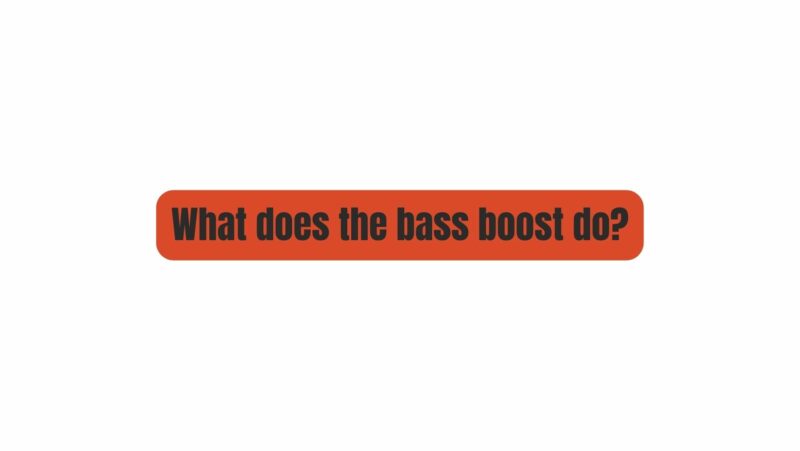Music, at its essence, is an emotional journey, and the heartbeat of that journey often lies in the deep, resonating thump of bass. It’s the soul-stirring sensation that rattles your bones and moves your spirit. To enhance this experience, audio equipment often offers a feature known as “bass boost.” But what exactly does bass boost do, and how does it shape your audio experience? In this article, we’ll embark on a sonic exploration to unveil the mysteries of bass boost, understand its functionality, and discover how it can transform your listening pleasure.
The Essence of Bass Boost
To begin, let’s demystify the concept of bass boost. At its core, bass boost is an equalization (EQ) feature found in audio equipment designed to elevate the lower frequencies within an audio signal. In simpler terms, it’s a tool that amplifies the bass notes, making them more prominent and impactful. Here are the key aspects to grasp about bass boost:
- Low-Frequency Emphasis: Bass boost specifically targets the low-end frequencies within your audio signal. It increases the volume of these frequencies to create a more pronounced bass response.
- Customizable Intensity: Most devices with bass boost functionality allow you to adjust the level or intensity of the bass boost effect. This means you can fine-tune the amount of low-end emphasis to suit your preferences.
- Enhanced Bass Effect: The primary purpose of bass boost is to provide a bass-heavy listening experience. It’s particularly ideal for genres like hip-hop, electronic dance music (EDM), and rock, where powerful basslines are an integral part of the music’s impact.
- Altering Frequency Response: Unlike some other audio controls, such as volume or balance, bass boost does alter the frequency response of your audio signal. It selectively boosts specific bass frequencies, which can lead to an altered tonal balance.
The Science Behind Bass Boost
To truly understand bass boost, it’s essential to delve into the science underpinning it. The key to this feature lies in the concept of equalization. Equalization in the audio realm refers to the adjustment of frequency response to achieve a desired tonal balance.
In the case of bass boost, the EQ curve employed often resembles a “shelving” filter. This filter boosts or cuts frequencies above or below a certain point, referred to as the cutoff frequency. For bass boost, the shelving filter boosts frequencies below the cutoff point, accentuating the bass.
The specific frequencies affected by bass boost can vary from one audio device to another. Some devices target a broad range of low frequencies, while others focus on specific bass frequencies within the sub-bass or mid-bass range. The adjustability of the bass boost feature allows you to tailor the low-end emphasis to your liking.
When to Engage Bass Boost
Now that we’ve demystified bass boost, let’s explore when it’s appropriate to use this feature:
- Music Genre Preference: If your musical preferences lean toward genres that prominently feature bass, such as hip-hop, EDM, dubstep, or reggae, bass boost can elevate your listening experience. It accentuates the basslines and delivers the intended impact of the music.
- Customizing Audio: Bass boost provides the means to customize the tonal balance of your audio to match your preferences and the type of music you’re enjoying. It’s a tool that allows you to make your audio experience uniquely yours.
- Personal Listening Pleasure: For individuals who relish a bass-heavy sound signature, using bass boost on your headphones or home audio system can provide a more satisfying and immersive listening experience.
Cautions and Considerations
While bass boost can be a potent tool to enhance your audio experience, it’s essential to use it judiciously and be aware of potential pitfalls:
- Distortion Risk: Excessive bass boost can overwhelm your audio equipment, leading to audible distortion. To avoid this, it’s crucial to find the right balance between bass enhancement and audio clarity.
- Frequency Imbalance: Bass boost selectively increases bass frequencies, which can result in an unbalanced sound profile. The boosted bass might overpower other frequency ranges, such as midrange and treble, leading to an uneven listening experience.
- Speaker and Headphone Quality: The effectiveness of bass boost depends on the quality and capacity of your speakers or headphones. Premium audio components are better equipped to handle increased bass levels without distortion.
- Listening Environment: The impact of bass boost can vary depending on your listening environment. What sounds great in one setting may not be suitable for another. It’s essential to consider the acoustics of your listening space.
Conclusion: Crafting Your Sonic Canvas
In the world of audio, bass boost is a powerful tool that allows you to delve into the depths of low-end frequencies, enhancing your musical enjoyment. Whether you’re an avid music lover seeking that heart-thumping bass or a casual listener looking to customize your audio experience, bass boost is there to help you sculpt the sonic landscape to your liking.
Remember, like any audio control, the key to unlocking the full potential of bass boost lies in understanding its effects, using it judiciously, and tailoring it to suit your preferences. By mastering this feature, you can embark on a sonic journey that resonates with your unique tastes, allowing you to feel the music in a way that’s truly personal and powerful.


